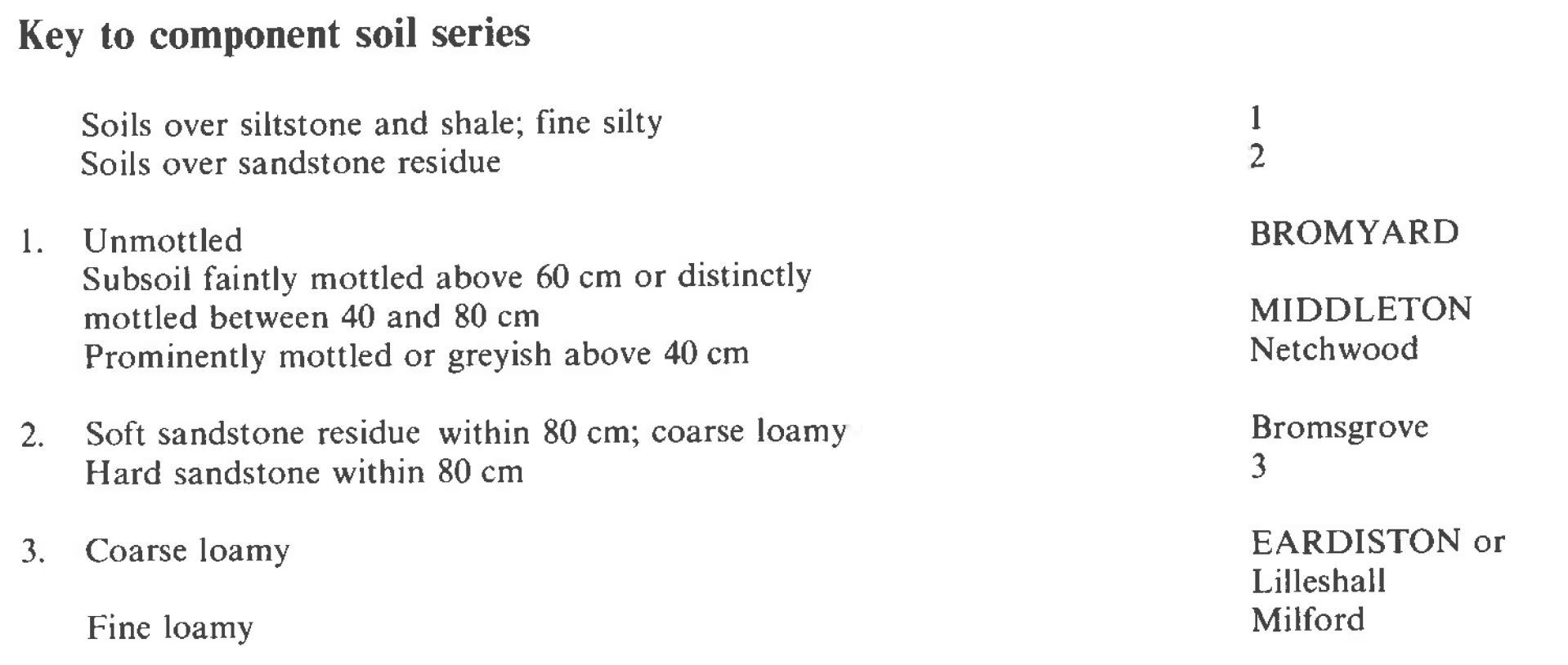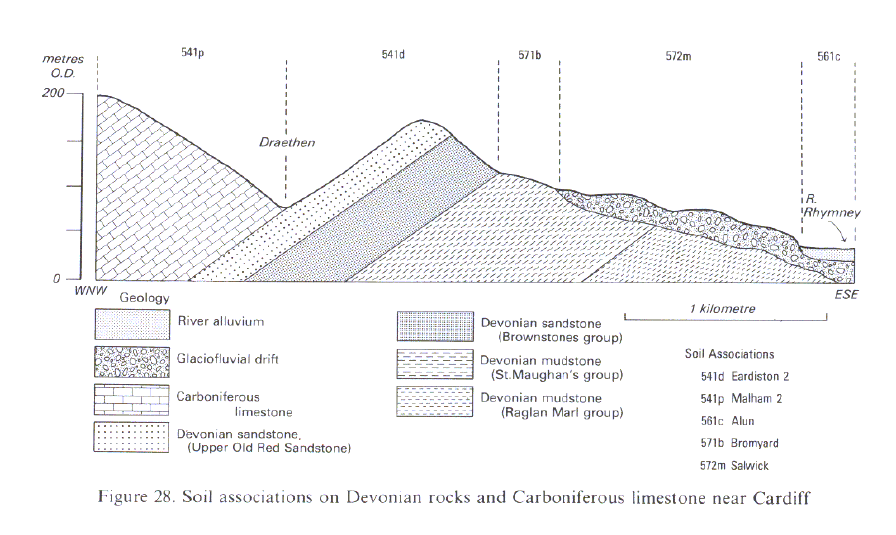
Soil Associations
0571b BROMYARD
Soil and site characteristics
Well drained reddish fine silty soils over shale and siltstone. Some similar soils with slowly permeable subsoils and slight seasonal waterlogging. Some well drained coarse loamy soils over sandstone. Risk of water erosion.
Geology
Devonian reddish silty shale. siltstone and sandstone
Cropping and Land Use
Cereals and short term grassland with stock rearing, some hops; deciduous woodland on steep slopes.
Component soil series
| Subgroup | Series name | Percentage | WRB 2006 link |
|---|---|---|---|
| 5.71 | BROMYARD | 50% | Chromic Luvisols |
| 5.72 | MIDDLETON | 15% | Chromic Endostagnic Luvisols |
| 5.41 | EARDISTON | 12% | Eutric Chromic Endoleptic Cambisols |
Covers 1485 km2 in England and Wales
Soilscapes Classification
| 8 |
Slightly acid loamy and clayey soils with impeded drainage |
0571b BROMYARD
Detailed Description
This association consists of well drained reddish fine silty soils over silty shales and soft siltstones and occasionally coarse loamy soils over sandstones. It is widespread, covering 1436 km² on Devonian rocks in the Welsh Borderland, Wales and South West England. The soil pattern closely reflects the underlying bedrock which is micaceous and often slightly calcareous where unweathered. Thin, impersistent, soft, fine grained sandstones are fairly common, as are greenish grey blotches and streaks. The fine silty Bromyard soils which belong to the typical argillic brown earths, are dominant on the silty shales and siltstones with the wetter Middleton series of stagnogleyic argillic brown earths common on flat and gently sloping sites. Where the sandstones are thick and persistent, the Eardiston series, a coarse loamy typical brown earth is recognized. Smaller inclusions of calcareous soils occur on impersistent rubbly argillaceous limestones (cornstones) and calcareous shales (Palmer 1976). The association is extensive in Hereford and Worcester and south Shropshire and the proportion of associate soils varies with the lithology. On Downtonian strata the Middleton series is the main associate-often on broad flat hillcrests, on gentle slopes at the head of small valleys or in thin Head on lower slopes adjacent to alluvium. Where the association is mapped on Dittonian rocks, the Eardiston series is the main associate on the frequent but discontinuous sandstones which occur as narrow outcrops forming hilltops and ridges. Downslope there is often a spring line at the junction with the underlying impervious shale so Middleton and Netchwood soils tend to be found adjacent to small patches of well drained Eardiston soils. Throughout the Dittonian succession, but principally at its base, occasional thinly interbedded argillaceous limestones form narrow ridges and knolls as between Dinmore and the Merbach Hills. Here the association includes sporadic patches of silty typical brown calcareous earths belonging to the Eastham series and typical argillic brown earths of the Hayton series (Palmer 1976) associated with the limestones. Fine loamy Milford soils (Wright 1980) are common where the association is mapped on Dittonian strata. They are widespread on the Bromyard Downs and their proportion increases south-westwards from the Golden Valley where thin interbedded sandstones and shales weather into fine loamy soils. The Bromyard association is also mapped in western Shropshire on the Alberbury Breccia of the Upper Carboniferous in Alberbury Park. Here Bromyard soils developed in silty mudstones are found in association with occasional profiles of Crediton series in calcareous conglomerates. In Wales the association is mapped west of Monmouth on broad gentle interfluves formed in Downtonian (Raglan Marl Group) and Dittonian (St Maughan's Group) rocks. There are smaller areas between Cardiff and Cwmbran, and near Presteigne. Sandstone outcrops are few and Eardiston soils are less frequent than in England. The wetter Middleton and Netchwood soils are found near springs and seepage lines. Some of the well drained soils contain greenish grey mottles inherited from the parent rock, which makes their distinction from similar but gleyed soils difficult.
The association extends into north-west Gloucestershire along the outcrop of the Old Red Sandstone. It is present around Dymock and as far south as Lydney. The Middleton series is the main associate in shallow valley floors or on broad flat hill tops.
Soil Water Regime
In dry districts the Bromyard series, with moderate permeability, is waterlogged for short periods only in winter, the duration depending on slope or long-term land use (Wetness Class I to II). Land under continuous cultivation will be more susceptible to surface wetness and waterlogging than that under permanent grassland because of the inevitable compaction and reduction of permeability induced by this management system. Eardiston series is underlain by permeable sandstone and so is well drained (Wetness Class I). The Middleton series is seasonally waterlogged (Wetness Class III) but responds to artificial drainage (Wetness Class II). In the wet climate of the fringes of the Black Mountains, where the field capacity period is greater than 200 days, Bromyard series is seasonally waterlogged (Wetness Class III) while the Middleton series is waterlogged for long periods in the winter (Wetness Class IV). The association rapidly absorbs winter rainfall although on steep slopes or on compacted arable land run-off is increased.
Cropping and Land Use
The soils provide good mixed-farming land most of which is under ley grassland, with permanent grass on steep slopes. Cattle and sheep rearing are important together with cereals, and good yields of cereals and grass are obtained in most seasons. Wheat is the main arable crop. Root crops, when grown, tend to be concentrated on the coarse loamy Eardiston series. Some fruit and hops are grown at lower elevations (less than 140 m O.D.), particularly in the climatically favoured areas between Hereford and Ledbury . In the dry country around Hereford, grass growth is checked by drought in the summer months. Elsewhere grass yields well for most of the year and the adequate surface bearing strength enables Bromyard and Eardiston pastures to be used with negligible poaching risk for all but the wettest winter periods. New leys on these soils have a surface bearing strength less than that of old grassland with its protective turf mat, and along with most pastures on the Middleton series, these have a significant poaching risk. Stocking rates and the time of grazing therefore need careful judgement. Bromyard and Middleton soils are water retentive and have low bearing strength when at or near field capacity. At such times cultivations should be avoided. Unless mismanaged or compacted, Bromyard soils can be worked in winter and spring after a rain-free period of about five days. In spring, especially in Shropshire, such periods are few and autumn cultivations are preferable. Early autumn ploughing is essential on Middleton soils and in wet years is usually impossible after September without causing structural damage. Because of their large silt and fine sand contents, the soils are particularly susceptible to capping and subsequent erosion, when recently ploughed or sparsely vegetated-especially where organic matter contents are small under long-term cultivation. The risks are greatest in autumn or winter when heavy rain falls on already saturated ground or in summer when thunder storms follow a dry spell. Periodic sheet and gully erosion over the centuries have given a characteristic pattern of shallow soils on brows and on headlands at the tops of fields, and deep colluvial soils on the upper sides of hedge banks and on footslopes. The shallow eroded soils give droughty patches with relatively small crop yields. Bromyard association soils become acid in the surface where unlimed, but pH increases with depth and is often neutral within 1 m, where the substratum is slightly calcareous. They usually have low or very low available phosphorus and although available potassium can also be low, Bromyard soils have considerable slowly available reserves (Arnold and Close 1961). Eardiston soils tend to have moderate levels of potassium which is unusual for a coarse loamy soil. Adequate magnesium is available and deficiency symptoms are rare. Boron deficiency is sometimes noted in swedes. Hardwoods flourish on soils of the Bromyard association. Sessile oak grows very fast on the Bromyard series. Ash also thrives on both Middleton and Bromyard soils and a similar yield class can be obtained. Sycamore and beech grow best on base-rich sites. Financial yields are much enhanced by growing broadleaved species in an even-aged mixture with Norway spruce, European larch or Western red cedar. Douglas fir grows quickly but has a tendency to wind-rock when young and may need expensive staking.
0571b BROMYARD
Distribution Map
 |
Note that the yellow shading represents a buffer to highlight the location of very small areas of the association.
Keys to component soil series
Midlands
 |
Wales
 |
Typical Landscapes
Wales
 |
All information Copyright, Cranfield University © 2025
Citation: To use information from this web resource in your work, please cite this as follows:
Cranfield University 2025. The Soils Guide. Available: www.landis.org.uk. Cranfield University, UK. Last accessed 26/04/2025
